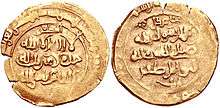Ibrahim of Ghazna
Ibrahim of Ghazna (1033–1099), was sultan of the Ghaznavid empire from April 1059 until his death in 1099.[1] Having been imprisoned at the fortress of Barghund, he was one of the Ghaznavid princes that escaped the usurper Toghrul's massacre in 1052.[2] After his brother Farrukh-Zad took power, Ibrahim was sent to the fortress of Nay,[3] the same fortress where the poet Masud Sa'd Salman would later be imprisoned for ten years.[4]
| Ibrahim | |
|---|---|
 | |
| Sultan of Ghaznavid Empire | |
| Reign | 1059–1099 |
| Predecessor | Farrukh-Zad |
| Successor | Mas'ud III |
| Born | 1033 |
| Died | 1099 |
| Issue | Mas'ud III |
| House | House of Sabuktegin |
| Father | Ma'sud I |
| Religion | Sunni Islam |
Following Farrukh's death, Ibrahim was recognized as the last surviving male Ghaznavid. A military escort was sent to fetch him from Nay and he entered Ghazna on 6 April 1059.[3] Ibrahim's reign was considered a golden age for the Ghaznavid empire, due to the treaties and cultural exchanges with the Great Seljuq empire.[5]
Life
Ibrahim was born during his father's campaign into Gurgan and Tabaristan(c. 1033).[6] He was reportedly had 40 sons and 36 daughters. One of these daughters married the great-great-grandfather of the historian Juzjani.[7]
Ibrahim's son, Mas'ud, married Gawhar Khatun, daughter of Seljuq sultan Malik Shah, as a condition of peace between the Great Seljuq empire and the Ghaznavid empire.[1]
Every year Ibrahim would copy the Quran by hand and send it to the caliph in Mecca.[8]
Reign
Ibrahim rebuilt towns and settlements and instituted a vigorous policy for the restoration of social peace and economic prosperity in the Ghaznavid empire, which had been initiated by his brother Farrukh-Zad.[7] During an unknown date, Ibrahim also arrested his vizier Abu Sahl Khujandi for unknown reasons. In 1060, at the request of the nobles of Ghur, Ibrahim invaded the region and deposed its ruler Abbas ibn Shith. He then had the latter's son Muhammad ibn Abbas placed on the Ghurid throne.[9]
Ibrahim sent his son, Mahmud, with an army of ghazis consisting of 40,000 cavalry to raid Doab, between 1063 and 1070.[10] Following Mahmud's successful campaigns into India, Ibrahim initially appointed him governor of India. He occupied temporarily the cities of Agra and Kannauj. He also attacked Malwa.[11] However, for reasons unknown, Mahmud fell out of favor, was imprisoned in the fortress of Nay and his brother, Mas'ud, took his place as governor of India.[12] Shorn of its western land, it was increasingly sustained by riches accrued from raids across Northern India, where it faced stiff resistance from Indian rulers such as the Paramara of Malwa and the Gahadvala of Kannauj.[13]
After 14 years of peace with the Great Seljuq empire, Ibrahim, in January 1073, sent an army into Sakalkand. His army met with initial success capturing Seljuq sultan Malik Shah's uncle, Uthman b. Chaghri beg, who was sent to Ghazna. However, an army led by the Seljuq Amir Gumushtegin Bilge bey and Anushtegin Gharchai, drove out the Ghaznavid army that had devastated Sakalkand.[14][15] In 1077/8, Ibrahim appointed Abd al-Hamid Shirazi as his vizier.[16]
In 1079, Ibrahim led a campaign into India, besieging a fortress in Pakpattan 120 Parasang(480 miles) from Lahore, taking it on 13 August 1079. The military commander at Lahore, Abul Najm Zarir Shaybani, and carried out successful raids against the Hindu cities of Benares, Thanesar, and Kanauj. Another main achievement of Ibrahim's reign, was the rise of Lahore as a great cultural center under the viceroyalty of his grandson Shirzad.
Death
Ibrahim died on 25 August 1099 ending a reign of 41 years. His tomb lies in the northeastern part of medieval Ghazna near Shaikh Radi d-Din 'Ali Lala's tomb.[17]
References
- Dames 1993, p. 157.
- Bosworth 1977, p. 46.
- Bosworth 1977, p. 50.
- Bosworth 1977, p. 66.
- Ziad 2006, p. 294.
- Bosworth 1977, p. 50-51.
- Bosworth 1977, p. 51.
- Bosworth 1977, p. 74.
- Bosworth 1968, p. 157.
- Wink 1997, p. 134.
- Bakshi, Gajrani & Singh 1997, p. 371.
- Bosworth 1977, p. 66-67.
- Bosworth 2007.
- Bosworth 1977, p. 53.
- Ibn al-Athir 2002, p. 180.
- Bosworth 2011.
- Bosworth 1977, p. 81.
Sources
- Bakshi, S.R.; Gajrani, S.; Singh, Hari (1997). Early Aryans to Swaraj. Vol.II. Brill.CS1 maint: ref=harv (link)
- Bosworth, C.E. (1968). "The Iranian World". In Boyle, John Andrew (ed.). The Cambridge History of Iran. Vol. 5. Cambridge University Press.CS1 maint: ref=harv (link)
- Bosworth, C.E. (1977). The Later Ghaznavids. Columbia University Press.CS1 maint: ref=harv (link)
- Bosworth, C.E. (2007). "Ghaznavids". Encyclopedia Iranica.CS1 maint: ref=harv (link)
- Bosworth, C.E. (2011). "ʿAbd-Al-Ḥamid b. Ahmad b. ʿAbd-Al-Ṣamad Širazi". Encyclopaedia Iranica.CS1 maint: ref=harv (link)
- Dames, M. Longworth (1993). "Ghaznavids". In Houtsma, M. Th. (ed.). E.J. Brill's First Encyclopaedia of Islam, 1913-1936. Brill.CS1 maint: ref=harv (link)
- Ibn al-Athir (2002). The Annal of the Saljuq Turks. Translated by Richards, D.S. Routledge.CS1 maint: ref=harv (link)
- Wink, André (1997). Al-Hind the Making of the Indo-Islamic World: The Slave Kings and the Islamic Conquests 11th-13th centuries. Vol.II. Brill.CS1 maint: ref=harv (link)
- Ziad, Homayra (2006). "Ghaznavids". In Meri, Josef W. (ed.). Medieval Islamic Civilization. Vol. I. Taylor & Francis.CS1 maint: ref=harv (link)
Ibrahim of Ghazna House of Sabuktegin Born: 1025 Died: 4 April 1059 | ||
| Regnal titles | ||
|---|---|---|
| Preceded by Farrukh-Zad |
Sultan of the Ghaznavid Empire 1053-1099 |
Succeeded by Mas'ud III |
| Wikiquote has quotations related to: Ibrahim of Ghazna |